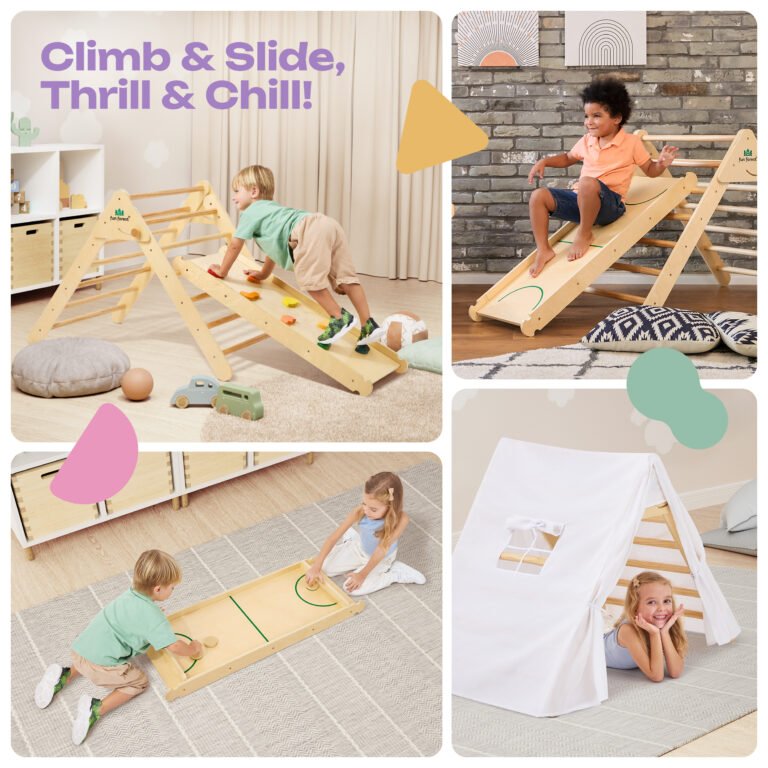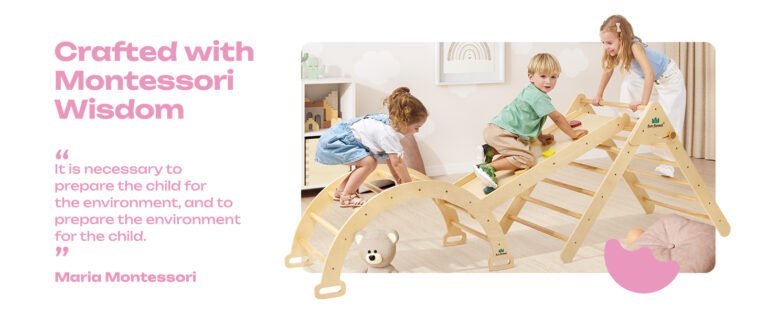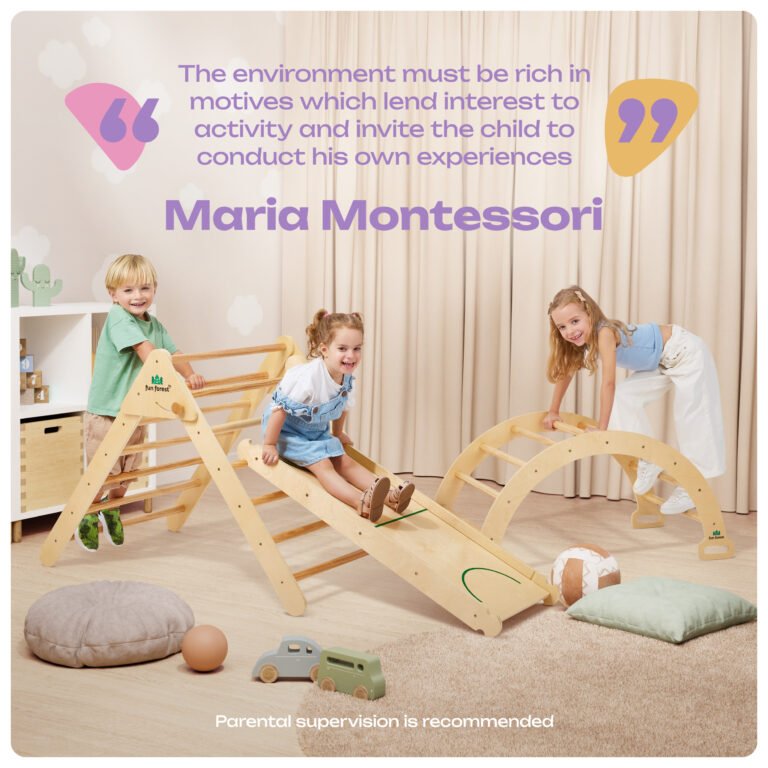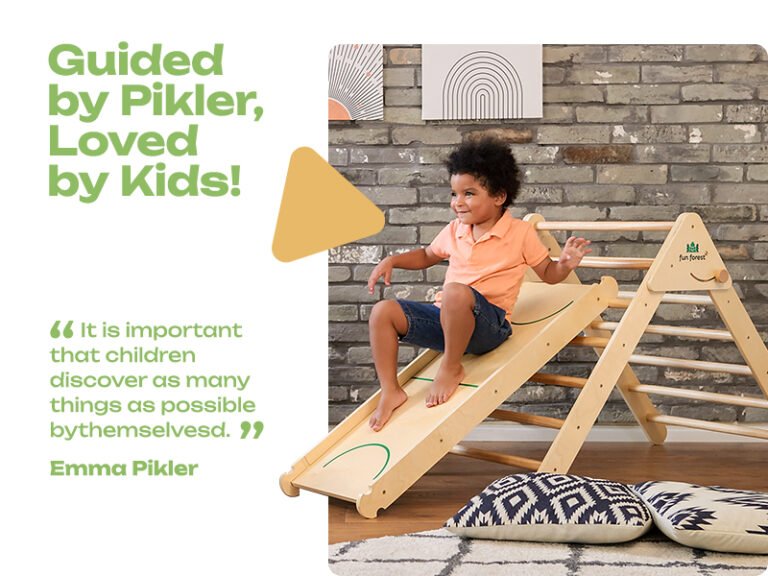Safe Climbing Toys for 3-Year-Olds: What Experts Recommend (2025 Guide)
Three-year-olds are climbing athletes. They’re stronger, more coordinated, and infinitely more confident than they were just a year ago. But here’s what every parent discovers: their climbing ambitions often far exceed their safety judgment. As we navigate 2025, child development experts have reached new conclusions about how to support these fearless little adventurers while keeping them genuinely safe.
This expert-backed guide synthesizes the latest research from pediatric specialists, movement therapists, and safety engineers to help you choose climbing equipment that matches your 3-year-old’s remarkable abilities while respecting their developmental limitations.

2025 Expert Insights: The 3-Year-Old Climbing Revolution
Latest Developmental Research
Recent studies from leading pediatric research centers reveal fascinating insights about 3-year-old development:
Motor Development Breakthroughs (2024-2025):
- Complex coordination emerges: 3-year-olds can now plan and execute multi-step climbing sequences
- Spatial reasoning advances: Improved ability to judge distances and assess climbing routes
- Bilateral integration peaks: Using both sides of body independently while maintaining balance
- Risk-reward calculation begins: Early development of appropriate risk assessment skills
Cognitive Development Updates:
- Executive function strengthening: Better planning and impulse control (though still developing)
- Problem-solving sophistication: Can analyze climbing challenges and adapt strategies
- Memory integration: Remember successful climbing techniques and apply them to new situations
- Social climbing emergence: Strong interest in climbing with peers and siblings
Expert Consensus on 3-Year-Old Climbing Needs
Leading specialists agree that 3-year-olds require fundamentally different climbing challenges than younger children:
Dr. Amanda Foster, Pediatric Physical Therapist:
“Three-year-olds need climbing equipment that provides genuine challenge without creating genuine danger. They’re capable of heights up to 4-5 feet, but the key is ensuring they can always get down safely and that falls won’t cause serious injury.”
Dr. James Liu, Child Development Researcher:
“At three, children begin to understand consequences, but their impulse control is still developing. The safest climbing equipment naturally guides good decisions rather than relying on the child to make them consistently.”
Maria Santos, Certified Safety Engineer:
“Our 2025 testing protocols specifically address the 3-year-old challenge: they’re strong enough to attempt dangerous climbs but not mature enough to consistently assess risks accurately.”
What Makes Climbing Equipment Expert-Recommended for 3-Year-Olds in 2025
Enhanced Safety Standards
Structural Requirements for Advanced Climbers:
- ASTM F963-24 compliance: Latest specifications for 3+ year climbing equipment
- Enhanced weight capacity: Minimum 100-pound capacity to accommodate growth and dynamic loading
- Multi-point stability testing: Verified stability under enthusiastic, multi-directional forces
- Height optimization: 36-48 inch maximum heights with graduated access options
Behavioral Safety Features:
- Self-limiting design: Structure prevents attempts beyond safe capability
- Visual safety cues: Clear indicators of safe versus challenging areas
- Natural progression paths: Obvious routes from simple to complex challenges
- Escape route accessibility: Multiple safe ways to descend from any position
2025 Material Science Advances
Next-Generation Safety Materials:
- Bio-based composites: New eco-friendly materials that outperform traditional plastics
- Smart wood finishes: Advanced non-toxic treatments that improve grip and durability
- Impact-absorbing surfaces: Materials that reduce injury risk from falls
- Weather-adaptive coatings: Finishes that maintain safety in various environmental conditions
Ergonomic Design Evolution:
- 3-year-old specific sizing: Rungs, grips, and spacing optimized for preschooler proportions
- Adaptive grip surfaces: Textures that provide security without causing abrasions
- Fatigue-resistant design: Equipment that maintains safety even during extended play sessions
- Multi-position comfort: Support for various climbing and resting positions
Expert Evaluation of 2025 Climbing Toy Categories
Traditional Playground Equipment
Expert Assessment:
❌ Generally NOT recommended for home use
Dr. Foster’s Analysis: “Commercial playground equipment is designed for supervised public spaces with specific safety surfacing. In home environments, the supervision and safety infrastructure often aren’t adequate for the risks these structures present.”
Specific Concerns:
- Heights often exceed safe limits for unsupervised play
- Designed for older children (typically 5-12 years)
- Requires professional installation and maintenance
- Hard surfaces and materials increase injury severity
Plastic Climbing Domes and Gyms
Expert Assessment:
⚠️ Use with significant caution
Dr. Liu’s Analysis: “While some plastic climbing structures can work for 3-year-olds, the quality varies dramatically. Many are too lightweight for confident climbers and can tip or shift during use.”
Safety Considerations:
- Stability concerns: Lightweight construction may not handle dynamic climbing
- Material degradation: UV exposure and temperature changes can weaken plastic
- Sharp edge formation: Plastic components can develop dangerous edges over time
- Limited longevity: Often outgrown or worn out within 6-12 months
Soft Play Climbing Sets
Expert Assessment:
⚠️ Adequate for beginners, insufficient for confident 3-year-olds
Maria Santos’ Analysis: “Soft play equipment serves a purpose for very cautious children, but most 3-year-olds need more substantial challenges. The lack of realistic climbing experience can actually impede proper skill development.”
Limitations for 3-Year-Olds:
- Insufficient structural integrity for confident climbers
- May not provide adequate skill-building challenge
- Can create false confidence that doesn’t transfer to real climbing
- Often becomes boring quickly for developing children
Wooden Climbing Triangles (Pikler Triangles)
Expert Assessment:
✅ HIGHLY RECOMMENDED across all expert categories
Dr. Foster’s Endorsement: “Pikler triangles represent the gold standard for 3-year-old climbing equipment. They provide appropriate challenge, excellent safety characteristics, and natural skill progression.”
Dr. Liu’s Research Findings: “In our longitudinal studies, children who use quality wooden climbing triangles show superior motor development, better risk assessment skills, and higher confidence in physical activities.”
Santos’ Safety Analysis: “The triangle geometry is inherently stable, the wood construction provides appropriate weight and durability, and the design naturally prevents most unsafe behaviors.”
Why Experts Unanimously Recommend Pikler Triangles for 3-Year-Olds
Developmental Alignment
Perfect Challenge Progression:
- Graduated difficulty: Natural advancement from simple to complex climbing
- Height appropriateness: Challenging without being dangerous for 3-year-olds
- Skill building support: Develops strength, coordination, and confidence systematically
- Long-term engagement: Continues to challenge children through age 6+
Cognitive Development Support:
- Spatial reasoning: Three-dimensional navigation builds mathematical thinking
- Problem-solving: Route planning and obstacle navigation enhance executive function
- Risk assessment: Safe practice of risk evaluation builds judgment skills
- Memory integration: Successful technique practice strengthens motor memory
Safety Engineering Excellence
Inherent Stability:
- Triangle geometry: Mathematically stable shape that cannot tip
- Weight distribution: Substantial construction handles dynamic forces
- Base width: Broader than child’s movement range for enhanced stability
- Center of gravity: Low positioning maintains stability during vigorous climbing
Age-Appropriate Design:
- Rung optimization: 8-10 inch spacing perfect for 3-year-old stride length
- Grip accommodation: Rung diameter ideal for preschooler hand size
- Surface safety: Smooth wood finish prevents splinters while providing grip
- Hardware security: All connections tested for durability and safety
Behavioral Safety Benefits
Natural Safety Teaching:
- Self-limiting height: Design prevents attempts beyond safe capability
- Obvious progression: Clear path from beginner to advanced challenges
- Intuitive use: Children naturally understand safe climbing patterns
- Confidence building: Success-oriented challenges build appropriate risk judgment
Parent Peace of Mind:
- Predictable use patterns: Design encourages consistent safe behaviors
- Supervision compatibility: Easy to monitor while allowing independence
- Quality assurance: Built to maintain safety characteristics over time
- Expert endorsement: Backed by decades of professional recommendation
Expert-Recommended Specifications for 3-Year-Old Climbing Equipment
Essential Safety Features (2025 Standards)
Structural Requirements:
- Height range: 36-42 inches maximum for optimal challenge-to-safety ratio
- Weight capacity: Minimum 100 pounds with dynamic load testing
- Stability base: Minimum 36-inch base width for inherent stability
- Material quality: Hardwood construction or equivalent strength materials
Design Specifications:
- Rung spacing: 8-10 inches optimal for 3-year-old climbing patterns
- Grip diameter: 1.25-1.5 inches for secure small hand grip
- Surface finish: Smooth, splinter-free with appropriate friction
- Edge treatment: All edges rounded to 0.25-inch minimum radius
Safety Certifications Required:
- ASTM F963-24: Latest toy safety specifications
- CPSC compliance: Consumer Product Safety Commission standards
- Non-toxic certification: Materials safe for extended contact
- Structural integrity testing: Independent verification of weight capacity and stability
Expert-Approved Feature Enhancements
Recommended Add-Ons:
- Reversible climbing ramp: Adds variety and different challenge types
- Safety padding: Appropriate ground covering for enhanced fall protection
- Weather protection: Covers or treatments for outdoor use
- Assembly quality: Professional-grade hardware and clear instructions
Features to Avoid:
❌ Electronic components: Add complexity without developmental benefit
❌ Decorative elements: Potential distraction or safety hazards
❌ Excessive height: Anything over 48 inches inappropriate for age group
❌ Sharp angles: Any design elements that could cause injury
❌ Unstable configurations: Designs that rely on perfect assembly for safety
The Fun Forest Expert Advantage
When experts evaluate climbing equipment for 3-year-olds, they consistently highlight the same features that make Fun Forest products exceptional:
🌲 Fun Forest Pikler Triangle
Expert-Validated Design for 3-Year-Olds:
🏆 Perfect Height Specification: 36-inch height hits the expert-recommended sweet spot
🔬 Research-Based Proportions: Rung spacing and diameter based on 3-year-old ergonomics
🛡️ Enhanced Stability: Triangle geometry provides inherent safety that experts trust
🌿 Premium Materials: Hardwood construction meets all expert safety requirements
✨ Safety-First Finish: Hand-sanded surfaces eliminate splinter risk
📋 Full Certification: Exceeds all 2025 safety standards and expert recommendations
Why Experts Choose Fun Forest:
- Proven track record: Years of safe use by families worldwide
- Quality construction: Built to professional standards that experts trust
- Age-appropriate challenge: Perfect difficulty level for 3-year-old development
- Long-term value: Equipment that grows with child’s abilities
🎯 Complete Fun Forest Pikler Set
Expert-Endorsed Comprehensive Solution:
🎪 Multiple Challenge Levels: Various configurations accommodate rapid 3-year-old development
🧗 Progressive Difficulty System: Natural advancement that experts recommend
👨👩👧👦 Family Integration: Components work for multiple ages simultaneously
🔧 Professional Assembly: All connections tested to expert safety standards
📈 Development Optimization: Configurations that support all areas of 3-year-old growth
🏅 Expert Validation: Recommended by pediatric specialists and safety engineers
Complete Set Expert Benefits:
- Sustained engagement: Variety prevents boredom and unsafe improvisation
- Skill progression: Multiple configurations support advancing abilities
- Social climbing: Accommodates play with siblings and friends safely
- Investment value: Comprehensive equipment reduces need for additional purchases
Expert Installation and Safety Guidelines
Setup Recommendations from Safety Professionals
Surface Requirements:
- Impact-absorbing ground cover: 2-inch minimum thickness foam mats or equivalent
- Fall zone calculation: 6-foot clearance on all sides minimum
- Level surface verification: Use of leveling tools to ensure stable placement
- Hazard elimination: Remove all hard objects from extended play area
Environmental Considerations:
- Lighting adequacy: Minimum 50 foot-candles for safe climbing visibility
- Temperature monitoring: Avoid extreme temperatures that affect material safety
- Weather protection: Indoor use preferred; outdoor use requires weatherproofing
- Supervision zones: Setup that allows easy adult monitoring without interference
Expert-Recommended Usage Guidelines
Session Management:
- Duration limits: 20-30 minute sessions to prevent fatigue-related accidents
- Energy assessment: Use during alert periods when child can focus on safety
- Break implementation: Regular rest periods to maintain attention and safety
- Weather considerations: Avoid use during high-energy weather that affects concentration
Skill Development Support:
- Progressive introduction: Start with basic climbing before advancing to complex routes
- Safety demonstration: Show proper hand placement and safe descent techniques
- Risk discussion: Age-appropriate conversations about climbing safely
- Success celebration: Positive reinforcement for safe climbing behaviors
Expert Predictions: Future of 3-Year-Old Climbing Safety
2025-2026 Trends
Emerging Technologies:
- Smart safety monitoring: Sensors that alert to unsafe climbing patterns
- Adaptive materials: Surfaces that respond to environmental conditions
- Injury prediction algorithms: AI that identifies potential safety risks
- Personalized difficulty adjustment: Equipment that adapts to individual child capabilities
Design Evolution:
- Biomechanical optimization: Equipment designed using 3D movement analysis
- Cognitive development integration: Climbing equipment that specifically supports brain development
- Environmental integration: Designs that work seamlessly indoors and outdoors
- Social climbing optimization: Equipment specifically designed for group play safety
Long-Term Safety Outlook
Dr. Foster’s 2025 Prediction: “We’re moving toward climbing equipment that not only keeps children safe but actively teaches them to assess and manage risks appropriately. The future is equipment that builds safety skills, not just provides safety.”
Dr. Liu’s Research Direction: “Our ongoing studies suggest that children who use high-quality climbing equipment early show better risk assessment, higher physical confidence, and fewer injuries throughout childhood.”
Making the Expert-Approved Choice
When child development experts, safety engineers, and pediatric specialists all agree on equipment recommendations, parents can choose with confidence. For 3-year-olds in 2025, that unanimous recommendation points to quality wooden climbing triangles that provide appropriate challenge within reliable safety parameters.
Expert Decision Framework:
Choose Expert-Recommended Equipment If:
✅ Your child shows confident climbing abilities
✅ You want equipment that grows with your child
✅ Safety and development are both priorities
✅ You value expert professional recommendations
✅ You want long-term value from your investment
Questions to Ask:
- Does this equipment meet 2025 safety standards?
- Is it recommended by child development professionals?
- Will it challenge my child appropriately without overwhelming them?
- Can it grow with my child’s developing abilities?
- Does it teach safe climbing behaviors naturally?
Your Expert-Backed Investment
Choosing climbing equipment for your 3-year-old doesn’t have to be guesswork. When you follow expert recommendations backed by research, safety testing, and professional experience, you can provide your child with optimal challenges while maintaining optimal safety.
Ready to choose the expert-recommended solution for your 3-year-old climber?
🌟 Expert Choice: Fun Forest Pikler Triangle – The unanimous expert recommendation for safe, challenging 3-year-old climbing
🎯 Expert Complete Solution: Fun Forest Set – Comprehensive expert-endorsed equipment for maximum development and safety
Your 3-year-old’s climbing adventures deserve the safety and quality that experts trust. Choose equipment that’s been tested, researched, and recommended by the professionals who understand child development best.
Because when experts agree, parents can climb with confidence.
Learn more in our complete Pikler Triangle guide








